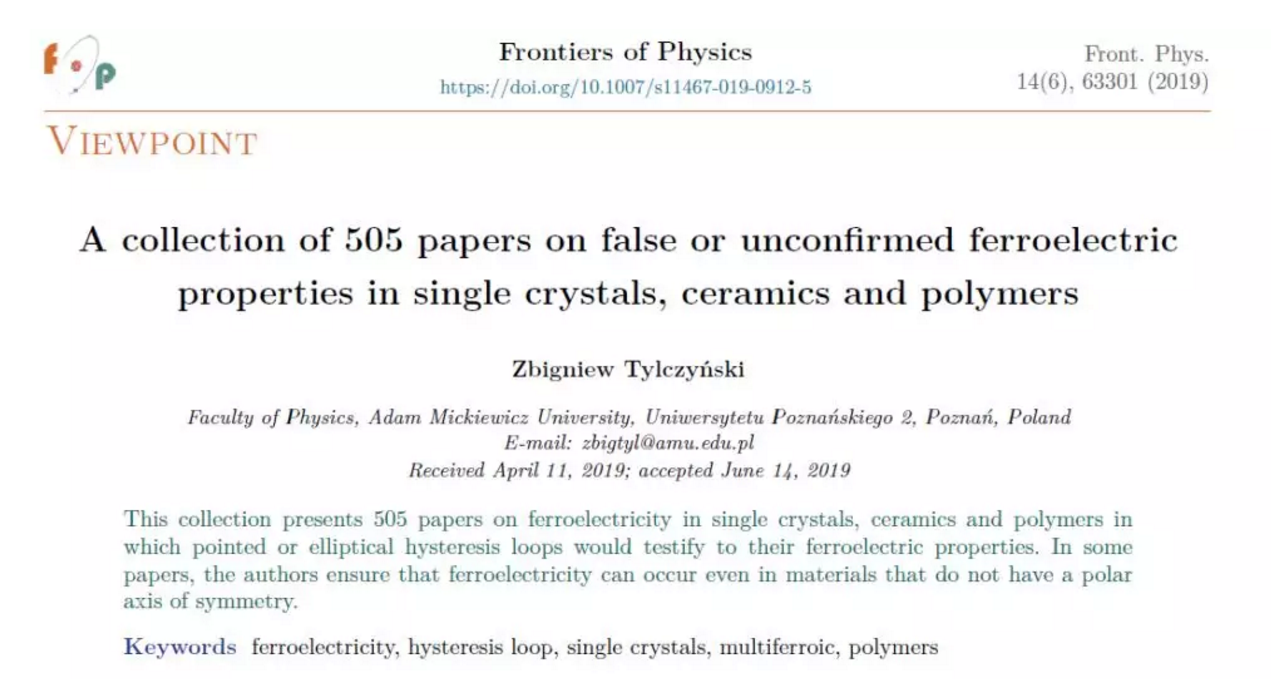博文
香蕉也能测出电滞回线?
|
全文下载:
VIEWPOINT
Zbigniew Tylczyński, A collection of 505 papers on false or unconfirmed ferroelectric properties in single crystals, ceramics and polymers, Front. Phys. 14(6), 63301 (2019)
香蕉也能测出电滞回线?
香蕉也能测出电滞回线?这不是开玩笑,这是在正规学术期刊上发表的论文获得的实验结果,是不是有点匪夷所思?
铁电性是材料科学里面的一个常见的概念,它是指在一些电介质晶体中,晶胞的结构使正负电荷中心不重合而出现电偶极矩,产生不等于零的电极化强度,使晶体具有自发极化,且电偶极矩方向可以因外电场而改变,呈现出类似于铁磁体的特点,晶体的这种性质叫铁电性。什么是自发极化呢?每个晶胞中原子的构型使正负电荷重心沿该方向发生相对位移从而使得晶体的单位晶胞内正负电荷中心不重合,形成偶极矩,从而会呈现出极性。而晶体构造的周期性和重复性,晶胞的固有电矩便会沿着同一方向排列整齐,使得晶体处于高度的极化状态,由于这种极化状态是在外电场为零时自发地建立起来的,因此称为自发极化。铁电性由法国的Valasek于1920年在罗息盐晶体中首次被发现。从那时起,许多有机和无机铁电材料被陆续发现。
在32种晶体学点群中铁电性只能存在于10种具有单一对称轴的点群,它们分别为:1(C1),2(C2),m(Cs),mm2(C2v),3(C3),3m(C3v),4(C4),4mm(C4v),6(C6),6mm(C6v)。根据铁电性的定义,极化矢量随着施加电场的方向而发生定向排列,从而产生本征的电滞回线。用铁电分析仪等设备可以直接测量材料的铁电性,只有饱和的P-E回线可以获得晶体的铁电性的宏观信息。材料显示铁电性质的另一个证据是在静电场中极化样品后观察热释电电流,只要电场方向发生变换,热释电电流信号就会发生变化。
铁电领域权威人士剑桥大学J. F. Scott教授 2008年在J. Phys.: Condens. Matter上发表了一篇Viewpoint 论文“Ferroelectrics go bananas”,表明对香蕉进行铁电测量居然可以得到非常逼真的电滞回线(如下图)。然而稍微有点材料科学常识的人都知道:香蕉不可能有铁电性。Scott之所以要发表这样一篇看似无厘头的文章,有其深层原因,近些年一批学术论文采用了这样的插图,并就此声称所得到的样品具有铁电性,椭圆型的电滞回线很容易产生实验假象。沿着Scott文章进行深入研究,Loidl通过宽频谱介电常数和电导的测量技术对香蕉做了进一步的分析和解释(“Bananas go paraelectric”),他们认为样品不均性、漏导、介电库仑阻塞等因素可能是导致这种赝铁电性产生的原因。

在进行同行评审的期刊,特别是在专门从事材料调查和研究的正规期刊上,得以发表的一些论文的作者声称,即使在没有极轴对称性的材料中也可能存在铁电性。不幸的是,这些文章都存在或多或少的缺陷,引发了科学文献的混乱。最近发表在Frontiers of Physics期刊上的“A collection of 505 papers on false or unconfirmed ferroelectric properties in single crystals, ceramics and polymers”文章中,波兰Adam Mickiewicz大学Zbigniew Tylczyński教授通过仔细阅读几十种专门用于材料调查和研究的科学期刊,从中识别并搜集了505篇涉及单晶、陶瓷和高分子聚合物中铁电性的论文,其中尖的或椭圆形电滞回线将证明其是否存在铁电性。文章里将其分类为三个部分:第一部分“单晶”,第二部分“多晶陶瓷”,第三部分“高分子聚合物”。每个部分都包含一个概括性的表格,其中列出了虚假的或未经证实的“铁电”物质的名称,列出其对称性和观察到的P-E回线的形状以及相应的参考文献。
作者搜集如此之多的文献并撰写这样一篇文章的想法是希望引起科学界的注意:有些作者声称在没有极轴的晶体中可能存在铁电性,曲解了实验结果,将呈现出椭圆形或尖的P-E回线作为铁电性存在的证据。关于铁电材料的这些已发表论文的概述揭示了一些常见的错误:
• 没有考虑到铁电性能只能存在于具有极轴对称性的材料中;
• 将呈现椭圆形或尖角P-E电滞回线作为铁电性存在的证据;
• 由于电场增加,增强剩余极化值只能证明介电损耗的增加,而不能证明自发极化存在;
• 在单晶的研究中仅仅用一个较小的最大介电常数去作为铁电相向顺电电相转变的证据。
这一批判性分析可以帮助审稿人和作者避免基于对实验数据的错误解释而错误地声称非铁电材料具有铁电性。
1
Can bananas also detect hysteresis loops?
Can bananas also detect hysteresis loops? This is not a joke, but a paperpublished in a formal academic journal. Is it a bit ridiculous?
What is spontaneous polarization? If the positive and negative charge centersin the unit cell of the crystal do not coincide, forming a dipole moment, itwill exhibit polarity. This phenomenon of polarization existing without anexternal electric field is called spontaneous polarization. This can only existin a 10-point symmetry group of crystals having polar axes: 1, 2, m, mm2, 3, 3m, 4, 4mm, 6,6mm. Crystals with such symmetry show pyroelectricity.
Ferroelectricity is a common concept in materials science. It refers to thefact that spontaneous polarization can be reversed under the action of anapplied electric field resulting in a characteristic hysteresis loop.Ferroelectricity can be directly measured using equipment such as ferroelectricanalyzers. Only saturated P-E hysteresis loops can inform about theferroelectric properties of the crystal. Another evidence that the materialexhibits ferroelectric properties is the observation of the thermoelectriccurrent after polarization of the sample in the electrostatic field, as long asit changes sign when the direction of the field changes. Ferroelectricity wasfirst discovered by Valasek in 1921 in sodium potassium tartrate tetrahydrate. Since then,many organic and inorganic ferroelectric materials have been discovered.
Professor of Cambridge University, J. F. Scott, published in 2008 apaper "Ferroelectrics go bananas" at Journal of Physics: CondensedMatter. He shows that the ferroelectric measurement of banana skin can get avery realistic hysteresis loop (see the figure below). However, people who havea little bit of material science knowledge know that bananas cannot beferroelectric. The reason why Scott wants to publish such a seemingly nonsensearticle has its deep historical background. In recent years, a number ofacademic papers have adopted such illustrations, and claimed that the samplesobtained have ferroelectricity. Interpretation ofsuch a P-E dependence that the material under study is a ferroelectric provesignorance of the principles of solid state physics by the experimenter. Following the Scott article, Loidl further analyzed and explained bananasthrough the measurement techniques of broad spectral permittivity andconductance. He showed that factors such as sample heterogeneity, leakageconductance, and dielectric coulomb blockage may be responsible for thispseudo-ferroelectric generation.
The authors of some of the papers published in peer-reviewed journals, especially in journals specializing in material surveys and research, claimthat ferroelectricity may exist even in materials without polar axis symmetry. Unfortunately, these articles have more or less flaws that have causedconfusion in the scientific literature. In the article "A collection of505 papers on false or unconfirmed ferroelectric properties in single crystals,ceramics and polymers" recently published in the journal Frontiers ofPhysics, Zbigniew Tylczyński, professor at the AdamMickiewicz Universityin Poznań, carefullyread dozens of scientific journals dedicated to material investigation andresearch. The sharp or elliptical hysteresis loops will prove its ferroelectricproperties. The article is divided into three parts: the first part of thesingle crystal, the second part of the polycrystalline ceramic, and the thirdpart of the high molecular polymer. Each section contains a table listing thenames of the false or unconfirmed "ferroelectric" substances, theirsymmetry and the observed shape of the P-E hysteresis loop and thecorresponding references.
An overview of these published papers on ferroelectric materials revealssome common mistakes:
• does not take into account that ferroelectricproperties can only exist in materials with polar axis symmetry;
• presentation of an elliptical or pointed P-Ehysteresis loop as evidence of ferroelectric properties;
• increasing the residual polarization value asthe electric field increases will only show an increase in dielectric loss, butnot the existence of spontaneous polarization;
• explain small maximum of the dielectric constantas evidence of the transition from ferroelectric to paraelectric phase.
This critical analysis can help reviewers and authors avoid erroneouslyclaiming ferroelectric properties based on misinterpretation of experimentaldata.

https://wap.sciencenet.cn/blog-115136-1196340.html
上一篇:可压流体系统中Kelvin-Helmholtz不稳定性演化过程中的非平衡行为和形态学特征
下一篇:表面电荷对单个CdSe/CdS棒状量子点发射偏振特性的影响
全部作者的其他最新博文
全部精选博文导读
相关博文
- • Building an Artificial Consciousness System with DIKWP(初学者版)
- • Cognitive Development and Mechanism of DIKWP Semantics(初学者版)
- • Cognitive DIKWP Development in Early Language Learning(初学者版)
- • Expression of Semantics in DIKWP Semantic Mathematics(初学者版)
- • Derivation of Semantics in DIKWP Semantic Mathematics(初学者版)
- • Semantic Mathematics Detailed within the DIKWP Model(初学者版)